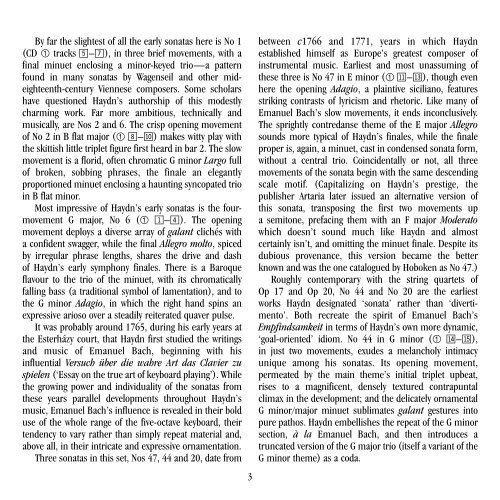Téléchargez le livret intégral en format PDF ... - Abeille Musique
Téléchargez le livret intégral en format PDF ... - Abeille Musique
Téléchargez le livret intégral en format PDF ... - Abeille Musique
Sie wollen auch ein ePaper? Erhöhen Sie die Reichweite Ihrer Titel.
YUMPU macht aus Druck-PDFs automatisch weboptimierte ePaper, die Google liebt.
By far the slightest of all the early sonatas here is No 1<br />
(CD 1 tracks 5–7), in three brief movem<strong>en</strong>ts, with a<br />
final minuet <strong>en</strong>closing a minor-keyed trio—a pattern<br />
found in many sonatas by Wag<strong>en</strong>seil and other mideighte<strong>en</strong>th-c<strong>en</strong>tury<br />
Vi<strong>en</strong>nese composers. Some scholars<br />
have questioned Haydn’s authorship of this modestly<br />
charming work. Far more ambitious, technically and<br />
musically, are Nos 2 and 6. The crisp op<strong>en</strong>ing movem<strong>en</strong>t<br />
of No 2 in B flat major (1 8–bl) makes witty play with<br />
the skittish litt<strong>le</strong> trip<strong>le</strong>t figure first heard in bar 2. The slow<br />
movem<strong>en</strong>t is a florid, oft<strong>en</strong> chromatic G minor Largo full<br />
of brok<strong>en</strong>, sobbing phrases, the fina<strong>le</strong> an e<strong>le</strong>gantly<br />
proportioned minuet <strong>en</strong>closing a haunting syncopated trio<br />
in B flat minor.<br />
Most impressive of Haydn’s early sonatas is the fourmovem<strong>en</strong>t<br />
G major, No 6 (1 1–4). The op<strong>en</strong>ing<br />
movem<strong>en</strong>t deploys a diverse array of galant clichés with<br />
a confid<strong>en</strong>t swagger, whi<strong>le</strong> the final Al<strong>le</strong>gro molto, spiced<br />
by irregular phrase <strong>le</strong>ngths, shares the drive and dash<br />
of Haydn’s early symphony fina<strong>le</strong>s. There is a Baroque<br />
flavour to the trio of the minuet, with its chromatically<br />
falling bass (a traditional symbol of lam<strong>en</strong>tation), and to<br />
the G minor Adagio, in which the right hand spins an<br />
expressive arioso over a steadily reiterated quaver pulse.<br />
It was probably around 1765, during his early years at<br />
the Esterházy court, that Haydn first studied the writings<br />
and music of Emanuel Bach, beginning with his<br />
influ<strong>en</strong>tial Versuch über die wahre Art das Clavier zu<br />
spie<strong>le</strong>n (‘Essay on the true art of keyboard playing’). Whi<strong>le</strong><br />
the growing power and individuality of the sonatas from<br />
these years paral<strong>le</strong>l developm<strong>en</strong>ts throughout Haydn’s<br />
music, Emanuel Bach’s influ<strong>en</strong>ce is revea<strong>le</strong>d in their bold<br />
use of the who<strong>le</strong> range of the five-octave keyboard, their<br />
t<strong>en</strong>d<strong>en</strong>cy to vary rather than simply repeat material and,<br />
above all, in their intricate and expressive ornam<strong>en</strong>tation.<br />
Three sonatas in this set, Nos 47, 44 and 20, date from<br />
3<br />
betwe<strong>en</strong> c1766 and 1771, years in which Haydn<br />
established himself as Europe’s greatest composer of<br />
instrum<strong>en</strong>tal music. Earliest and most unassuming of<br />
these three is No 47 in E minor (1 bm–bo), though ev<strong>en</strong><br />
here the op<strong>en</strong>ing Adagio, a plaintive siciliano, features<br />
striking contrasts of lyricism and rhetoric. Like many of<br />
Emanuel Bach’s slow movem<strong>en</strong>ts, it <strong>en</strong>ds inconclusively.<br />
The sprightly contredanse theme of the E major Al<strong>le</strong>gro<br />
sounds more typical of Haydn’s fina<strong>le</strong>s, whi<strong>le</strong> the fina<strong>le</strong><br />
proper is, again, a minuet, cast in cond<strong>en</strong>sed sonata form,<br />
without a c<strong>en</strong>tral trio. Coincid<strong>en</strong>tally or not, all three<br />
movem<strong>en</strong>ts of the sonata begin with the same desc<strong>en</strong>ding<br />
sca<strong>le</strong> motif. (Capitalizing on Haydn’s prestige, the<br />
publisher Artaria later issued an alternative version of<br />
this sonata, transposing the first two movem<strong>en</strong>ts up<br />
a semitone, prefacing them with an F major Moderato<br />
which doesn’t sound much like Haydn and almost<br />
certainly isn’t, and omitting the minuet fina<strong>le</strong>. Despite its<br />
dubious prov<strong>en</strong>ance, this version became the better<br />
known and was the one catalogued by Hobok<strong>en</strong> as No 47.)<br />
Roughly contemporary with the string quartets of<br />
Op 17 and Op 20, No 44 and No 20 are the earliest<br />
works Haydn designated ‘sonata’ rather than ‘diverti -<br />
m<strong>en</strong>to’. Both recreate the spirit of Emanuel Bach’s<br />
Empfindsamkeit in terms of Haydn’s own more dynamic,<br />
‘goal-ori<strong>en</strong>ted’ idiom. No 44 in G minor (1 bp–bq),<br />
in just two movem<strong>en</strong>ts, exudes a melancholy intimacy<br />
unique among his sonatas. Its op<strong>en</strong>ing movem<strong>en</strong>t,<br />
permeated by the main theme’s initial trip<strong>le</strong>t upbeat,<br />
rises to a magnific<strong>en</strong>t, d<strong>en</strong>sely textured contrapuntal<br />
climax in the developm<strong>en</strong>t; and the delicately ornam<strong>en</strong>tal<br />
G minor/major minuet sublimates galant gestures into<br />
pure pathos. Haydn embellishes the repeat of the G minor<br />
section, à la Emanuel Bach, and th<strong>en</strong> introduces a<br />
truncated version of the G major trio (itself a variant of the<br />
G minor theme) as a coda.
















